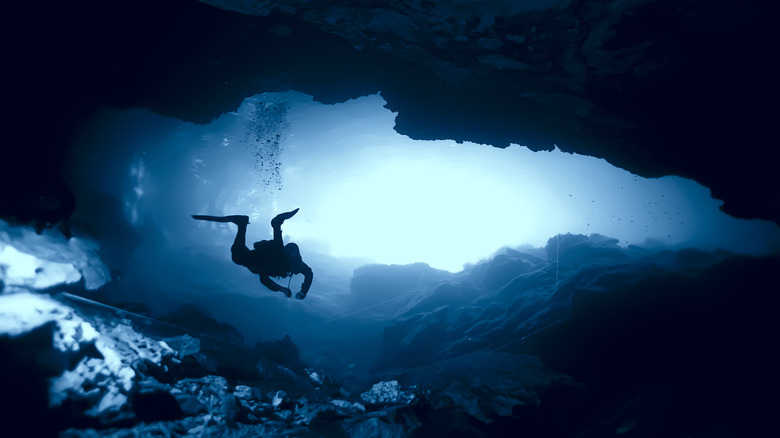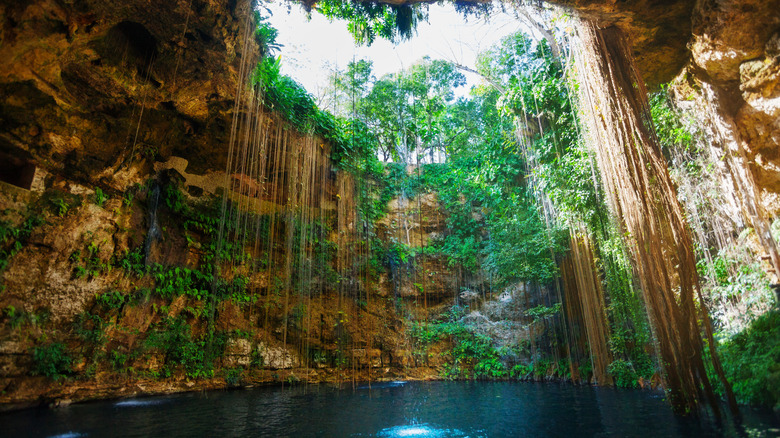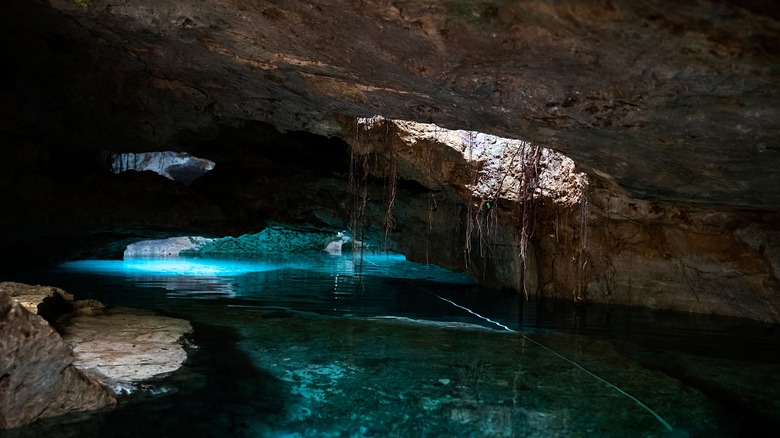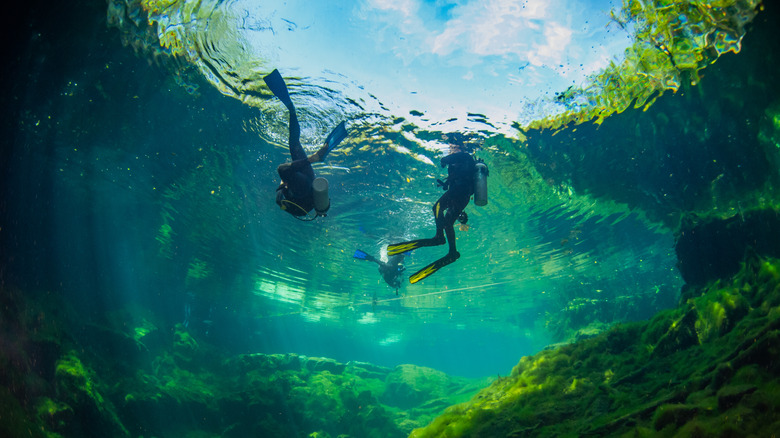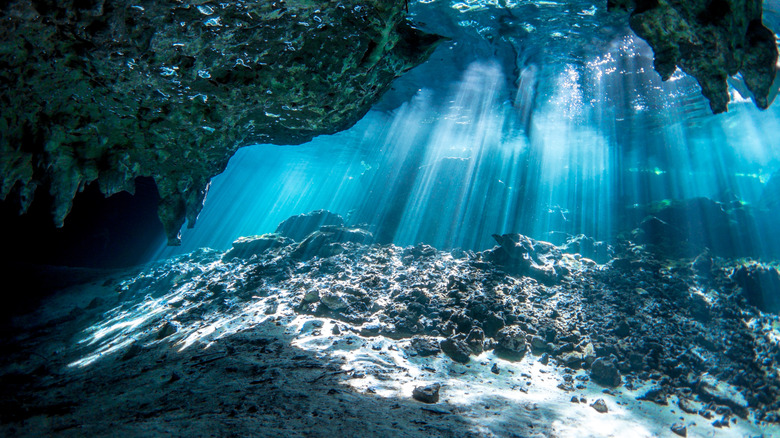What To Know Before You Dive Into The Yucatán's Famous Cenotes
Caves are creepy. There. We said it. Of course, that's probably exactly what lures adventurers, archeologists, and the just plain curious to explore twists and turns into darkness that leads to who knows where. Or who knows what. The creepiness of caves is so embedded in our collective consciousness that some of the most popular books and movies of the 20th and 21st centuries build on that fear of the unknown.
Steven Spielberg's "Indiana Jones and the Temple of Doom" — and underground temple we argue was more cave-ish than temple-like — had us on the edge of our seats as Indy survived an ambush, underground flood, and a crocodile-infested underground river. In 2021, M. Night Shyamalan's "Old" employed a no-way-out underground river as a metaphor for the inevitability of aging. Jules Verne's 1864 novel, "Journey to the Center of the Earth," follows its protagonists through a subterranean world and across a vast underground sea (via Britannica).
The common thread? All three stories play on our fear of the unknown. That sort of what's-under-the-bed or don't-turn-out-the-lights little shiver we experience when we can't quite see what's around the corner — or below the surface. Like looking into a deep water-filled cavern that appears to be a bottomless pit. Something like, say, a cenote.
What are cenotes?
Pronounced seh-no-tay, according to Cenote Finder, cenotes form when underwater caves collapse. While cenotes exist all over the world, including in the United States, Canada, Belize, Australia, and Zimbabwe, and the Dominican Republic, according to The Travel, they are disproportionately prevalent in and around Mexico's Yucatán Peninsula. By some accounts, the peninsula may be home to more than 7,000 cenotes. Of those, approximately 2,200 are officially mapped and registered. Why so many? As Goldilocks of fairy-tale lore said, the conditions were just right. According to Cenote Finder, millions of years ago, the Yucatán Peninsula, a vast slab of limestone, was an enormous underwater reef. As the sea level ebbed, the exposed limestone landscape revealed thousands of caves and sinkholes, many connected by an intricate maze of underwater rivers.
On the surface, cenotes can look like idyllic swimming holes. The water is clear and inviting. Lush vines may drape dramatic rock formations. The setting is cozy and inviting. Maybe even romantic. Like a snug hideaway. But there's more to the Yucatan's cenotes than meets the eye. Remember that maze of underwater rivers — the hidden places that beckon those adventurous spirits? It's lurking just beneath the surface. Are they safe to explore? Or is danger waiting in the darkness?
What lies beneath?
Archeological finds suggest Mayans who inhabited the Yucatán Peninsula as early as 2500 B.C. (via History), had a love-hate relationship with cenotes. Some became protected sources of fresh water. Others may have been considered mystical, or even sinister. Case in point, Sac Uayum, pronounced sock-wye-OOM, according to National Geographic, near the village of Mayapán. Even in the 21st century, locals steer clear of this particular ancient sinkhole. "Drinking water from that cenote is generally considered taboo," archaeologist Bradley Russell told National Geographic in 2014. "It's kind of off-limits. People don't let their children play near there. And there's a lot of beliefs around the cenote having some sort of evil forces or malevolent forces associated with it."
During a multi-day exploration of the cenote, Russell and his team discovered human and bovine skeletal remains. It's unclear if the remains were sacrificial or if the cenote once served as a burial ground. Russell leans toward the burial ground theory. "Maybe they're higher status individuals," he told National Geographic. "It's hard to say. It seems to me that this is sort of a place of honor, that this is, you know, one of the more holy places in these cities and these cenotes."
To dive or not to dive?
By and large, Yucatán's cenotes are safe to explore. With a few caveats. First and foremost, know your limits. If tight spaces make your heart flutter — not in a good way — think twice before you sign on the dotted line. According to RushKult, tour companies that offer cenote diving excursions in the Yucatán are required to ensure the underwater path is at least wide enough for two divers to pass through in tandem. That may sound like plenty of space, but it can feel very different if you're an inexperienced diver breathing via SCUBA equipment. Which brings up another key point. Because cenotes don't technically qualify as caves, cave-diving accreditation isn't required. Yay, you say? Okay, but that freedom to dive comes with responsibility in the form of, we repeat, knowing your limits.
Another RushKult piece of advice worth sharing: Don't succumb to peer pressure. RuskKult reports some of the most serious underwater cenote incidents happen because inexperienced divers — divers who would have been happier swimming on the idyllic surface in the sunshine amid draping vines — pushed themselves too far. Finally, if you get disoriented in the dark, or just don't like being in dark places, exploring the twists and turns of an underwater river system is probably not for you.
If you're a novice diver and still hellbent on doing a deep(er) dive, RushKult recommends testing your limits by doing a couple of open-water dives before delving into the underwater world of cenotes.
Taking the plunge
When you're ready to dive, SCUBA Diving says it's important to discuss your experience and skill level with the dive operator and suggests a few cenotes that may be a good match for explorers taking their first plunge. Dos Ojos (Two Eyes) is named for its resemblance to two eyes connected by a cavern. It splits into two dive lines with a maximum depth of 30 feet and is filled with stunning stalactites and stalagmites.
Another beginner-friendly cenote, according to SCUBA Diving, Garden of Eden (aka Ponderosa) may be a good choice for groups who have mixed interest in underwater exploration. From its rim, it's a dreamy jungle swimming hole perfect for surface snorkeling. The subterranean cavern line begins at a rock ledge where beams of sunlight break through the water to create the illusion of a shimmering underwater curtain.
Choosing a reputable tour operator for a guided tour of cenotes in Quintana Roo is about to get a bit easier. According to the Cancun Sun, tourism officials recently agreed on a resolution designed to regulate tour operators. The goal is to ensure registered tour operators are adhering to basic safety standards. Tourism officials in the area hope to have an updated database completed in 2023.
